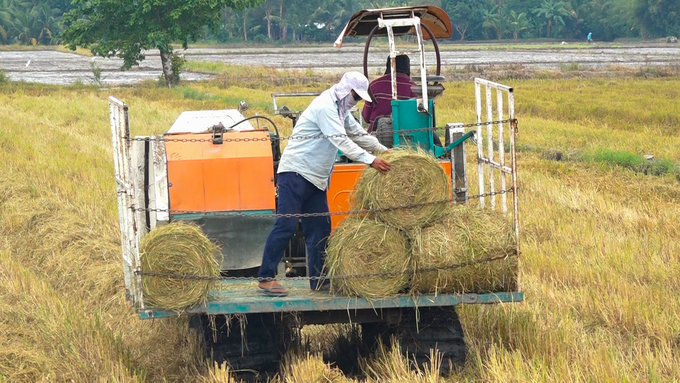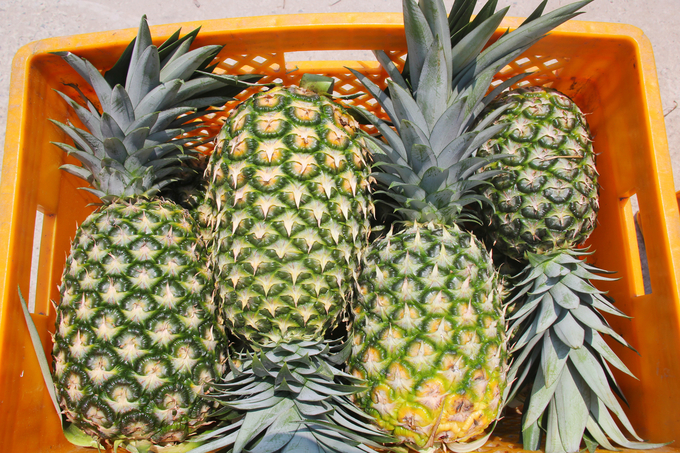November 27, 2025 | 11:45 GMT +7
November 27, 2025 | 11:45 GMT +7
Hotline: 0913.378.918
November 27, 2025 | 11:45 GMT +7
Hotline: 0913.378.918
In the context of agricultural production in association with the goal of sustainable development and environmental protection, which is also known as the circular economy model, agricultural by-products are regarded as renewable resources in the production process chain. Agricultural by-products subsequently create value-added companion products as well as minimize the impact of environmental pollution.

The crop production sector has nearly 89 million tons of post-harvest by-products. Photo: Kim Anh.
According to the report on biomass survey in Vietnam conducted by the World Bank and data from the General Statistics Office, the volume of annual agricultural by-products in Vietnam is estimated at nearly 157 million tons. Namely, the Mekong Delta has 39.4 million tons of agricultural by-products, accounting for 26% of the total volume of the country. Agricultural by-products are mainly created in 4 sectors including: Crop production has nearly 89 million tons of post-harvest by-products from crops and post-processing by-products, with the rate of collection and treatment reaching 52.2%; The livestock sector has 61 million tons of agricultural by-products in the form of cattle and poultry manure, not including livestock and poultry by-products, with a collection and treatment rate of over 79%; The forestry sector has at least 5.5 million tons of agricultural by-products from sawdust during processing as well as collected and treated post-harvest bark.
The trend of developing technology to combine renewable sources, promote the application of technical advances to optimize biomass sources has always been a topic of great interest to scientists.
The most notable scientific researches include those on the technology of processing agricultural by-products using biological products. This technology focuses on researching the treatment of agricultural by-products as fertilizer, growing medium, animal feed or studying the activity of microbial products in cellulose decomposition.

Post-harvest pineapple leaves often become valuable by-products in the textile industry. Photo: Kim Anh.
Another noteworthy technology is extracting and obtaining natural active ingredients from agricultural by-products. According to Assoc. Prof. Dr. Pham Anh Tuan from the Vietnam Institute of Agricultural Engineering and Post-harvest Technology, the highlight of this technology is the source of by-products. They originate from fruit post-processing such as peels, seeds, etc., which are rich in biologically active ingredients including: fiber, amino acids, vitamins, minerals among many others. After extraction, these agricultural by-products will become a valuable source of preparations used in functional foods.
Some organic wastes such as rice husks, egg shells, and banana peels have been shown to be capable of producing nanoparticles.
Post-harvest pineapple leaves are also used to extract new materials that are both durable and environmentally friendly, one of which is pineapple leaves fiber fabric. This special material is used in the textile industry. In addition, the remaining fiber is also reused as organic fertilizer.

Coconut by-products are reused to create high-value handicraft products. Photo: Kim Anh.
Processing seafood by-products can earn 4 to 5 billion USD thanks to high technology
Regarding the seafood sector, there are over 1 million tons of agricultural by-products stemming from the processing activities, with a relatively high collection and treatment rate of 90%.
Businesses have began to invest in modern and high-tech factories in order to extract biological compounds for the cosmetic and pharmaceutical industries. These investments include: extracting chitin and chitosan from shrimp shells; collagen and gelatin from catfish skin; fish oil and so on. These potentials have laid the foundation for the circular economy in the seafood industry to develop in the future, with high added value as the goal.
According to statistics, the value of seafood by-product processing industry in Vietnam is estimated to reach approximately 275 million USD in 2020. The exploitation space is still largely available, if the by-products of the seafood industry are fully exploited using high technology, the industry can expect to earn from 4 to 5 billion USD.
To achieve this goal and increase the efficiency of agricultural by-products utilization, the Government needs to innovate mechanisms and policies. The reduction of corporate income tax and import tax on equipment and technology will encourage businesses to invest in the field of collecting, packaging, transporting, preserving and processing by-products to connect the value added chain in agriculture. On the other hand, it is necessary to research, develop, transfer and effectively apply high as well as new technologies in the field of agricultural by-products processing.
Regarding solutions to develop technology for agricultural by-products processing, Assoc. Prof. Dr. Pham Anh Tuan said that it is necessary to re-evaluate the current level and scale of technology application in each production field. Additionally, categorize agricultural by-products into groups with large output according to the content of active ingredients in the by-products. Thereby, creating a basis for proposing appropriate and effective technological solutions.
Moreover, Assoc. Prof. Dr. Pham Anh Tuan believes that producing 2nd generation biofuels from agricultural by-products from rice straw, bagasse, tree trunks, etc., require specific support policies from the Government to encourage investment from businesses; so that 2nd generation biofuels can develop fully until 2030.
the Ministry of Science and Technology approved the national key science and technology program on "Research, application and development of technology for processing and preserving agro-forestry-fishery products and mechanization in agriculture from 2021 to 2030" on July 14, 2022. Most notably, the program includes content dedicated to processing agricultural, forestry and fishery by-products.
Translated by Nguyen Hai Long

(VAN) Tay Ninh’s livestock sector is undergoing a major transformation, applying high-tech, closed-loop circular models to build sustainable value chains.
/2025/11/26/3627-4-082628_818.jpg)
(VAN) From a small café on the red basalt highlands, Le Van Hoang started a business with clean coffee, building Enjoi Coffee into a symbol of organic agriculture in the Lam Dong plateau.
/2025/11/25/0045-1-135246_13.jpg)
(VAN) Ca Mau is researching a model of sea-encroaching embankments combined with viaducts and logistics service zones, aiming both to prevent erosion and create land funds for marine economic development.

(VAN) The information was shared at the seminar 'Urban Agriculture - Solutions for Developing Green Spaces,' organized by the Kinh te & Do thi Newspaper and the Biotechnology Center of Ho Chi Minh City.
/2025/11/19/4141-2-132831_216.jpg)
(VAN) One of Japfa's outstanding solutions is implementing digital transformation and artificial intelligence (AI) to optimize operations, enhance productivity, and advance sustainable development.
/2025/11/19/4847-1-093540_448.jpg)
(VAN) The Gia Lai Provincial People’s Committee had a working session with the delegation of the U.S. Department of Agriculture, the State of Idaho, and representatives of the State's leading enterprises.

(VAN) Ca Mau has a sufficient foundation to become a strong regional aquaculture center, where production integrates the economy, the environment, and the lives of the people.